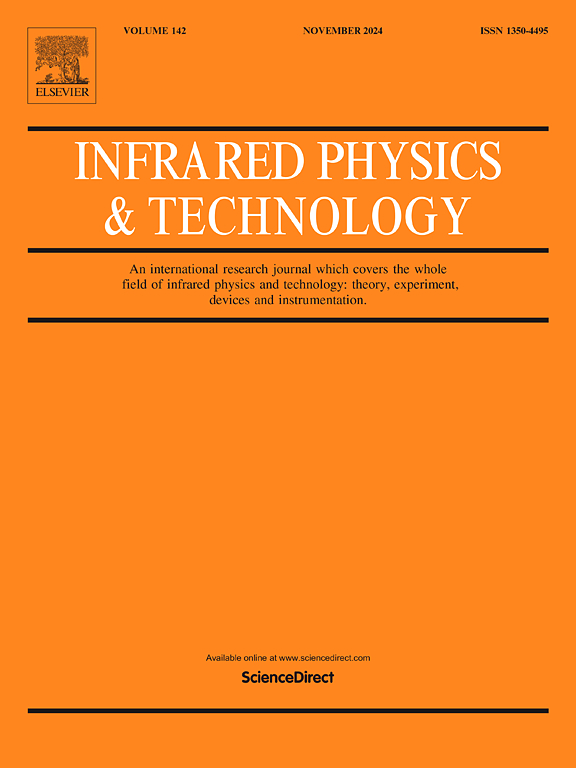CrBi2Te4-based mode-locked fiber laser with three switchable operating states
IF 3.1
3区 物理与天体物理
Q2 INSTRUMENTS & INSTRUMENTATION
引用次数: 0
Abstract
In recent years, 2D materials have been widely used in the field of optoelectronics, and these 2D materials have further improved the performance of fiber lasers. CrBi2Te4 is a member of the 2D material family known as topological insulators, featuring unique ferromagnetic properties and potential for saturation absorption. In this paper, we study the saturation absorption characteristics of CrBi2Te4-PVA nanosheets and CrBi2Te4 D-type fibers, and verify their nonlinear absorption characteristics in erbium-doped fiber lasers. When CrBi2Te4-PVA nanosheets are used as SAs, 10th-order harmonic pulses with a pulse width of 765.1 fs are generated. Utilizing CrBi2Te4 D-type fibers as saturable absorbers (SAs) leads to the generation of dark solitons and bright-dark soliton pairs, with average output powers reaching a maximum of 2.38 mW and 3.12 mW, respectively. To the best of our knowledge, this is the first presentation of a mode-locked fiber laser with the CrBi2Te4-based SA, and also the first study of bright and dark soliton properties of a CrBi2Te4-based fiber laser. It is foreseeable that CrBi2Te4 will become an appealing candidate for bright and dark soliton fiber lasers.
基于crbi2te4的三种可切换工作状态的锁模光纤激光器
近年来,二维材料在光电子领域得到了广泛的应用,这些二维材料进一步提高了光纤激光器的性能。CrBi2Te4是二维材料家族的一员,被称为拓扑绝缘体,具有独特的铁磁性和饱和吸收的潜力。本文研究了CrBi2Te4- pva纳米片和CrBi2Te4 d型光纤的饱和吸收特性,并验证了它们在掺铒光纤激光器中的非线性吸收特性。当CrBi2Te4-PVA纳米片作为SAs时,产生脉冲宽度为765.1 fs的10阶谐波脉冲。利用CrBi2Te4 d型光纤作为可饱和吸收剂(SAs)可产生暗孤子和亮-暗孤子对,平均输出功率最大分别达到2.38 mW和3.12 mW。据我们所知,这是第一次使用基于crbi2te4的SA实现锁模光纤激光器,也是第一次研究基于crbi2te4的光纤激光器的亮孤子和暗孤子特性。可以预见,CrBi2Te4将成为明暗孤子光纤激光器的理想候选材料。
本文章由计算机程序翻译,如有差异,请以英文原文为准。
求助全文
约1分钟内获得全文
求助全文
来源期刊
CiteScore
5.70
自引率
12.10%
发文量
400
审稿时长
67 days
期刊介绍:
The Journal covers the entire field of infrared physics and technology: theory, experiment, application, devices and instrumentation. Infrared'' is defined as covering the near, mid and far infrared (terahertz) regions from 0.75um (750nm) to 1mm (300GHz.) Submissions in the 300GHz to 100GHz region may be accepted at the editors discretion if their content is relevant to shorter wavelengths. Submissions must be primarily concerned with and directly relevant to this spectral region.
Its core topics can be summarized as the generation, propagation and detection, of infrared radiation; the associated optics, materials and devices; and its use in all fields of science, industry, engineering and medicine.
Infrared techniques occur in many different fields, notably spectroscopy and interferometry; material characterization and processing; atmospheric physics, astronomy and space research. Scientific aspects include lasers, quantum optics, quantum electronics, image processing and semiconductor physics. Some important applications are medical diagnostics and treatment, industrial inspection and environmental monitoring.

 求助内容:
求助内容: 应助结果提醒方式:
应助结果提醒方式:


